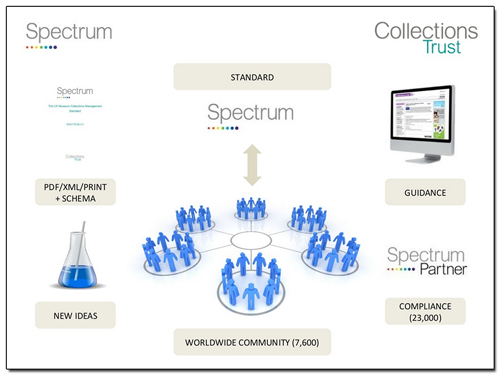FactMiners joins the Library, Archive, and Museum (LAM) tech community in congratulating the members of the CIDOC-CRM Special Interest Group for its kick-off to 2015 with release of Version 6.0 of the International Council of Museums (ICOM) Conceptual Reference Model. In addition to the major point update to the model's Reference Document, the CIDOC-CRM SIG also announced a collaboration with the UK-based Collections Trust to create a CIDOC-CRM extension for the Trust's widely-used and highly-regarded SPECTRUM standard for museums' collections management systems.

The CIDOC-CRM (tweeted/hashtagged here and elsewhere as #cidocCRM) serves as a metamodel providing definitions and a formal structure for describing the implicit and explicit concepts and relationships used in cultural heritage documentation. FactMiners is committed to #cidocCRM-driven design for our Open Source social game and exploratory personal and professional "serious fun" research platform.
"Early adopter use cases in the museum community are understandably focused on the descriptive, or ontological, aspects of the CIDOC-CRM. Designing and developing new software systems based on a rigorous metamodel is not the first thing you do with such a resource." said Jim Salmons, tech lead, researcher, and founder of FactMiners and The Softalk Apple Project, "We are very encouraged by publication of the new edition of the Reference Document together with the SPECTRUM announcement. Given the mission and community of The Collections Trust, this is very good news for any museum techies and researchers interested in #cidocCRM-based development projects."
"For our part," Salmons continued, "FactMiners is announcing the launch of our 'Year of the #cidocCRM Full-Graph Deep Dive'. We're asking Kindred Spirits interested in #cidocCRM-driven software design and development to tweet and tag their posts and communications with #cidocCRMdev and #cidocCRMgraph. These hashtags will help focus communication within the museum and broader LAM tech communities specific to these important emerging topics."
In addition to rallying interest in #cidocCRM-driven development within the museum informatics community, FactMiners will increase its outreach activity to engage the Neo4j and broader graph database communities in the exploration and development of a "full graph" implementation of the #cidocCRM.
FactMiners will also engage Neo Technology, the Structr folks, and vendors in the graph visualization community, like KeyLines, to join us in making a contribution to the global cultural preservation movement by working together this year to create a new Neo4j/Structr-based replacement for the www.CIDOC-CRM.org community website. This site is used as a central repository for the #cidocCRM model and its various information resources and news about this ISO standard metamodel. As new developers embrace the #cidocCRM, the community website will be increasingly important. An interactive Neo4j and Structr based site with "live document" visualizations and cross-referencing for the #cidocCRM metamodel will be an ideal way to showcase our web, app, and visualization technologies while making an important contribution to global cultural preservation.
"2015 looks to be the year that the CIDOC-CRM gets a real 'shakedown cruise' as a broader community of software designers and developers begin to explore and use this valuable resource within the cultural heritage community." Salmons said, "And FactMiners is happy to be a part of these exciting developments in the evolution of Internet and its use in the preservation and transmission of our cultural heritage. Keep up the great work CIDOC-CRM SIG! Full speed ahead #cidocCRMdev and #cidocCRMgraph!"

